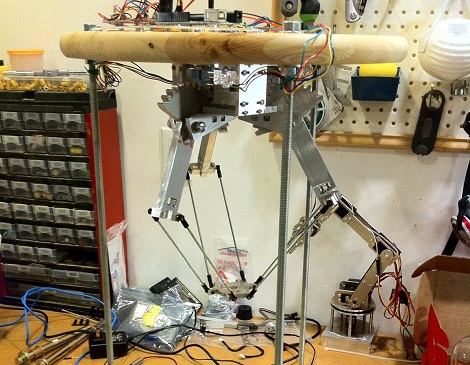
Sometimes, not all our builds work out the way we hoped. That’s what happened to [Rob] and his attempt at a Delta robot that does stereo lithography. A Delta robot is capable of very fast and precise movements, so [Rob] slapped a laser module on the end of the arms. After putting some UV curing resin in front of the laser, he was left with a blob of goo and we’re trying to figure out why.
[Rob] thinks the admittedly terrible print quality was due to diffraction and the reflective build plate. If this were the case, we’d agree with the assessment that adding some dye to the resin would help. Some commentors on [Rob]’s blog have suggested that he’s running the laser too slowly. It’s a shame [Rob] scrapped his build and turned it into a plain-jane X & Y axis build. Delta robots can be really damn fast, and adding a printer to one might mean prints that take minutes instead of hours. There are a few people working to get a Delta RepRap off the ground, but this project still has another prototype or two before that happens. Check out [Rob]’s attempt at Delta robot stereolithography after the break.
Thanks to [techartisan] for sending this one in.
[youtube=http://www.youtube.com/watch?v=-Thz-v1NF6s&w=470]
















Ive grown rather tired of seeing “my delta can draw” and “watch my delta play with balls” videos so I thought that Rob’s project was great…hopefully if enough people show it some love he will get back to work on it…I see great promise in the concept.
To further inspire, share my love of atypical delta applications and check out this video showing a commercial contact scanner that uses parallel kinematics to manipulate the probe head…. http://youtu.be/P19pPf5mjpI
didnt realize the video had so little of the actual scan mechanism shown….check out this one as well http://www.youtube.com/watch?v=KA-oEvmXlfk&feature=player_detailpage#t=42s
Servo mirrors > delta robots.
as mentioned in my next comment….
Servo mirrors (galvanometers) spread their beam from a central point resulting in lowered accuracy and part distortions the further you depart from center. This issue is what led Huntington to use a distributed fiberoptic/microlightswitch array on an X axis carriage in the Araldyte Digitalis system.
As tiny as this beaker build is….galvo or DLP would certainly be superior in speed with a negligible distortion in most parts….but scaled up the delta and cartesian systems have distinct advantages by maintaining beam perpendicularity
I disagree with the “minutes vs hours” but the delta does offer speed improvements on the typical Cartesian scan system…
while still slower than the use of galvanometers its parallel head would maintain beam perpendicularity eliminating the spread distortion galvanometer and dlp based SLA systems suffer as you move towards the edge of their build platforms.
This would mean a delta should be superior in build quality and dimensional stability in larger scale applications than Galvo or DLP SLA and faster than Cartesian systems….sounds like a good combo to me….GET BACK TO WORK ROB! LOL
i think the reflection off the metal thing or the resion is reflecting the laster causing … a blob XD
doesn’t make too much sense having it so high up off the surface with a rig like that, I would have expected to see this closer to the surface.
why would it need to be close to the surface? its not deposition…its a laser…the beam doesnt care if the surface is 1 inch or 1 foot away.
Only when PERFECTLY collimated. It’s far easier to have the beam close and focus it exactly, than have it floating around above the tabletop and try and achieve collimation.
The main reason for the height of the laser is clearance for the Z axis arm that goes over side of the beaker.
my main consideration is accuracy, the rig looks like it wobbles a bit, that’s all. if it were closer, or had a fixed down pointing laser, it might be better.
Impressive!!!, too bad that he didn’t keep the delta way.
also, does anyone know of a DIY UV curing resin? that could be a real hack.
“does anyone know of a DIY UV curing resin?”
I do. But it’s rather complicated and expensive.
I’ve found this https://nano-cemms.illinois.edu/materials/3d_printing_full
is this the same uv resine you know of?
there you can find the experiment well documented
if someone need more information
Thanks.
Cool build..
Could it be that as the platform connector arm descends through the resin, it displaces the resin and could put the focal point of the laser off by a fraction of a mm per step down so by the time the print is a few mm high, it’d be off be maybe a mm
Yes, I plan on accounting for that in the firmware.
Did you note that UV curing resin often needs to be preheated before it will cure?
I think this has to do with the absorption, as it heats up it needs less energy to cure.
I discovered this problem when attempting to make a homemade lens assembly for my Laserjet mech based etcher, and it never set under UV. Put the same glue outside on a hot day and it set in five minutes.
Possibly add a simple switched IR halogen bulb (i.e. IR pass filter) to heat up the workspace.
this is not true for all UV cure resins.
I think this has to do with the absorption, as it heats up it needs less energy to cure.
This is incorrect.
I discovered this problem when attempting to make a homemade lens assembly for my Laserjet mech based etcher, and it never set under UV. Put the same glue outside on a hot day and it set in five minutes.
Probably because UV from the sun is extremely intense.
Heating up the build tray from underneath with a hot plate made of salvaged from broken plasma panel thermal conductive strip and some nichrome wire would also work.
You can also get self adhesive thermal pad here, that would also work.
Mailme on mandoline at cwgsy dot net for more info.
I also noticed the reflected beam (haloed ) on the delta’s laser assembly. I think a non-reflective coating on the base that is in the resin would help with the loss of precision. Also I wonder if you should decouple the movement of the base in the resin from the movement of the delta. I noticed a fair amount of up and down movement that would cause eddy flow in the resin.
Great job. Please don’t give up!
Randy
This was my idea!!! Except i am using three vertical columns to hold the motors and head… Also an extruder rather than a laser with resen….